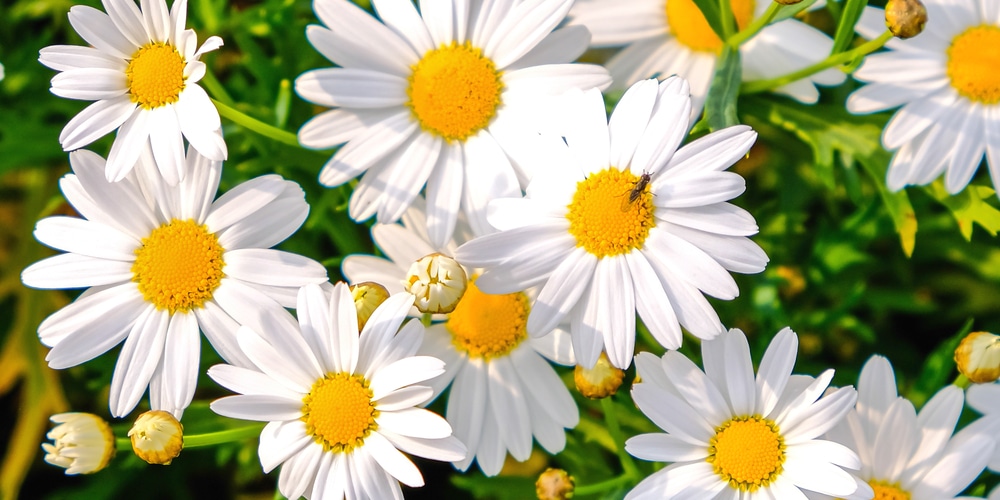Daisies and sunflowers are both iconic flowers. They commonly appear as bright spots in landscaping and fresh blooms on a tablescape. People instantly have similar mental images when thinking of a daisy vs. sunflower.
So, which one is better? Let’s look at the similarities and differences between Daisy vs. Sunflower and let you decide.
The Daisy
There are over 69 different types of daisies. If you desire a pop of color, Gerbera daisies are your go-to. You can choose from red, purple, yellow, pink, orange, lavender, salmon, and even multi-colored petals.
Use
A daisy brings to mind a smiling, happy flower. With its white petals, bright yellow center, and brilliant green foliage, the daisy is often spotted on greeting cards, in bouquets, and dotting the centers or edges of flower beds.
Daisies are the universal symbol of comfort and happiness, blending well in a bouquet with other flower varieties. Daisies also make a lovely ground cover for a yard.
Where To Plant
Daisies make beautiful additions to any flower bed with regular weekly watering and 6-8 hours of full sunlight.
Daisies have a height that ranges from 6-18 inches and can be planted as individual plants or as a grouping of several varieties. The daisy also makes a good centerpiece for a low-flower bed or a corner rock garden. Alternatively, it is perfect for garden borders.
Depending on your region, daisies can be perennials or annuals. Additionally, the plants can be potted and brought indoors in areas where temperatures drop below optimal levels.
Care
When considering daisy plants to beautify your outdoor living areas, it’s crucial to look at their requirements for soil, sunlight, and temperature preferences. Most varieties require 6-8 hours of full sunlight, good soil drainage, and temperatures between 30-90 degrees. They will be damaged by frost or extremely high temperatures.
Daisies are smaller plants with distinct color variations capable of producing multiple blooms throughout the growing season. Daisies should be watered thoroughly once per week. Be careful not to let the crown stay saturated, as root rot could result. To keep daisies blooming, use a micro-nutrient-rich plant fertilizer and snip wilted blooms.
The Sunflower
The sunflower is the flower of summer. With over 70 different varieties, colors range from pale yellow to deep orange with black centers which later develop into seeds.
Use
Unlike a daisy, sunflowers serve not only as beautification but also as a farming crop.
In the U.S., over 3 million acres of sunflowers are grown each year to provide sunflower oil, seeds to snack on, and commercial bird seed. By-products from pressed seeds are made into livestock feeds and also used as fuel.
If a flower that produces something other than a beautiful bloom is your goal, the sunflower head can be harvested and dried. The seeds from the sunflower are edible for both humans and animals, making a delicious snack.
Additionally, in a flower arrangement, smaller varieties of sunflowers make a beautiful, summertime statement.
Where To Plant
If farming is not your ideal usage for a sunflower, they make a beautiful addition to any yard or flowerbed. Sunflowers are a magnificent bright spot growing far taller than other plants, they are hardy and adept at getting the most water from any soil condition.
A sunflower is hardy even in dry climates, rotating its head as the sun moves across the sky for optimal sunlight exposure.
Ranging in height from 4-12ft, sunflowers can be used along a fence line, at the back of a flowerbed, or on the corners of a property line. Some people have planted them around bird baths to not only provide shade but also seeds for the birds to forage when the heads die off.
Care
Sunflowers require full sun with a spacing of at least 12 inches apart. If planting in rows or dispersed through a vegetable garden, give at least 2 feet between rows to allow for optimal growth.
Daisy vs. Sunflower flowers are also slightly different. Sunflowers only bloom once per season with flowers much larger than a daisy. If used as a crop, strategic rotation and timing can allow for two harvests per year.

